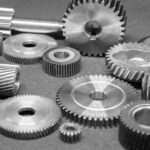
● Pitch surface: The surface of the imaginary rolling cylinder (cone, etc.) that the toothed gear may be considered to replace.
● Pitch circle: A right section of the pitch surface.
● Addendum circle: A circle bounding the ends of the teeth, in a right section of the gear.
● Root (or dedendum) circle: The circle bounding the spaces between the teeth, in a right section of the gear.
● Addendum: The radial distance between the pitch circle and the addendum circle.
● Dedendum: The radial distance between the pitch circle and the root circle.
● Clearance: The difference between the dedendum of one gear and the addendum of the mating gear.
● Face of a tooth: That part of the tooth surface lying outside the pitch surface.
● Flank of a tooth: The part of the tooth surface lying inside the pitch surface.
● Circular thickness (also called the tooth thickness) : The thickness of the tooth measured on the pitch circle. It is the length of an arc and not the length of a straight line.
● Tooth space: The distance between adjacent teeth measured on the pitch circle.
● Backlash: The difference between the circle thickness of one gear and the tooth space of the mating gear.
Backlash =Space width – Tooth thickness
● Circular pitch p: The width of a tooth and a space, measured on the pitch circle.
● Diametral pitch P: The number of teeth of a gear per inch of its pitch diameter. A toothed gear must have an integral number of teeth. The circular pitch, therefore, equals the pitch circumference divided by the number of teeth. The diametral pitch is, by definition, the number of teeth divided by the pitch diameter.
● Module m: Pitch diameter divided by number of teeth. The pitch diameter is usually specified in inches or millimeters; in the former case the module is the inverse of diametral pitch.
● Fillet : The small radius that connects the profile of a tooth to the root circle.
● Pinion: The smaller of any pair of mating gears. The larger of the pair is called simply the gear.
● Velocity ratio: The ratio of the number of revolutions of the driving (or input) gear to the number of revolutions of the driven (or output) gear, in a unit of time.
● Pitch point: The point of tangency of the pitch circles of a pair of mating gears.
● Common tangent: The line tangent to the pitch circle at the pitch point.
● Base circle : An imaginary circle used in involute gearing to generate the involutes that form the tooth profiles.
· Line of Action or Pressure Line: The force, which the driving tooth exerts at point of contact of the two teeth. This line is also the common tangent at the point of contact of the mating gears and is known as the line of action or the pressure line. The component of the force along the common tangent at the p point is responsible for the power transmission.
The component of the force perpendicular to the common tangent through the pitch point produces the required thrust.
· Pressure Angle or Angle of Obliquity (φ): The angle between pressure line and the common tangent to the pitch circles is known as the pressure angle or the angle of obliquity.
For more power ‘transmission and lesser pressure on the bearing pressure angle must be kept small. Standard pressure angles arc and 25°. Gears with 14.5° pressure angles have become almost obsolete.
· Path of Contact or Contact Length: Locus of the point of contact between two mating teeth from the beginning of engagement to the end is known as the path of contact or the contact length. It is CD in the figure. Pitch point P is always one point on the path of contact. It can be subdivided as follows:
Path of Approach: Portion of the path of contact from the beginning of engagement to the pitch point, i.e. the length CP.
Path of Recess: Portion of the path of contact from the pitch point to the end of engagement i.e. length PD.
· Arc of Contact: Locus of a point on the pitch circle from the beginning to the
end of engagement of two mating gears is known as the arc of contact in fig. 3.22, APB
or EPF is the arc of contact. It has also been divided into sub-portions.
Arc of Approach: It is the portion of the arc of contact from the beginning of engagement to the pitch point, i.e. length AP or EP.
Arc of Recess: Portion of the arc of contact from the pitch point to the end of engagement is the arc of recess i.e. length PB or PF.
· Angle of Action (δ): It is the angle turned by a gear from the beginning of engagement to the end of engagement of a pair of teeth i.e. the angle turned by arcs of contact of respective gear wheels. Similarly, angle of approach (a) and angle of recess (β) can be defined.
S=a+ β


